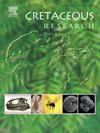Tithonian–Berriasian calpionellid and calcareous dinocyst biostratigraphy, and microfacies in the Torre de’ Busi section (Lombardian Basin, northern Italy)
IF 1.7
3区 地球科学
Q1 GEOLOGY
引用次数: 0
Abstract
Tithonian and lower Berriasian pelagic carbonate deposits of the Torre de’ Busi section (Lombardian Basin, northern Italy) were studied in detail in terms of their microfacies, calpionellid and calcareous dinocyst biostratigraphy, and integrated with calcareous nannofossils and magnetic stratigraphy.
Calpionellid zonation was revised, modifying the archival, unpublished data. Three calpionellid zones (Chitinoidella, Crassicollaria and Calpionella) and six subzones (Longicollaria dobeni, Chitinoidella boneti, Tintinnopsella remanei, Crassicollaria intermedia, Calpionella alpina and Remaniella ferasini) were identified, spanning from the topmost lower Tithonian to the lower Berriasian. Correlations between the calpionellid zones and magnetozones combined with calcareous nannofossil zones, are consistent with most Tethyan sections. The base of the C. alpina Subzone is quantitatively illustrated and based on high-resolution frequency analysis of calpionellid taxa.
Calcareous cysts were studied in the Torre de’ Busi section for the first time. Five calcareous dinoflagellate zones were distinguished. The lower Tithonian contains the Committosphaera pulla–Carpistomiosphaera tithonica, Parastomiosphaera malmica and the lowest part of Colomisphaera tenuis zones. In the upper Tithonian the Colomisphaera tenuis, Colomisphaera fortis and the lower part of Stomiosphaerina proxima zones were documented. The upper part of the St. proxima Zone is present in the lower Berriasian. The calcareous dinocyst zones and their correlation with magnetozones align well with available Tethyan records.
The Torre de’ Busi section represents a fully pelagic environment with a relatively large amount of radiolarians and sponge spicules. A major microfacies change, from radiolarian to calpionellid-dominated microfacies, occurs in the upper Tithonian (base of the Cr. intermedia Subzone, base M19r), close to the base of the Maiolica Formation. This level is characterized by a decrease in calcareous dinocyst frequencies, and an increase in calpionellids, which correlates with a major speciation phase of nannoconids.
意大利北部伦巴第盆地Torre de ' Busi剖面的铁索尼亚-贝里亚calpionelides和钙质dinocyst生物地层及微相
以意大利北部伦巴第盆地Torre de ' Busi剖面为研究对象,结合钙质纳米化石和磁性地层学,对其微相、钙鞘和钙质藻囊生物地层学进行了详细研究。修订了Calpionellid分区,修改了未发表的档案数据。鉴定出3个冠层(Chitinoidella、Crassicollaria、Calpionella)和6个亚层(Longicollaria dobeni、boneti、Tintinnopsella remanei、interassicollia、alpcalpionella alpina和Remaniella ferasini),分布于下梯统至下berberasian。calpionelides带与磁石带结合钙质纳米化石带的相关性与大多数特提斯剖面一致。在高分辨率频率分析的基础上,定量地说明了高山杉木亚带的基础。本文首次在Torre de ' Busi切片研究钙质囊肿。划分出5个钙质鞭毛带。下梯统包括Committosphaera pulla-Carpistomiosphaera tithonica, Parastomiosphaera malmica和Colomisphaera tenuis带的最低部分。在上梯统,记录到的有窄带Colomisphaera tenuis、窄带Colomisphaera fortis和近带Stomiosphaerina proxima下部。圣比邻带的上部位于贝里亚下部。钙质藻囊带及其与磁带的相关性与现有的特提斯记录一致。Torre de ' Busi剖面代表了一个完全的远洋环境,具有相对大量的放射虫和海绵针状体。微相变化主要发生在靠近马陶利卡组基底的上梯统(Cr.中亚带基底,M19r基底),由放射虫微相转变为卡先锋微相为主。这一水平的特征是钙质藻囊的频率减少,而calpionellids的频率增加,这与纳米孢子的主要物种形成阶段有关。
本文章由计算机程序翻译,如有差异,请以英文原文为准。
求助全文
约1分钟内获得全文
求助全文
来源期刊

Cretaceous Research
地学-地质学
CiteScore
4.10
自引率
19.00%
发文量
235
审稿时长
12 weeks
期刊介绍:
Cretaceous Research provides a forum for the rapid publication of research on all aspects of the Cretaceous Period, including its boundaries with the Jurassic and Palaeogene. Authoritative papers reporting detailed investigations of Cretaceous stratigraphy and palaeontology, studies of regional geology, and reviews of recently published books are complemented by short communications of significant new findings.
Papers submitted to Cretaceous Research should place the research in a broad context, with emphasis placed towards our better understanding of the Cretaceous, that are therefore of interest to the diverse, international readership of the journal. Full length papers that focus solely on a local theme or area will not be accepted for publication; authors of short communications are encouraged to discuss how their findings are of relevance to the Cretaceous on a broad scale.
Research Areas include:
• Regional geology
• Stratigraphy and palaeontology
• Palaeobiology
• Palaeobiogeography
• Palaeoceanography
• Palaeoclimatology
• Evolutionary Palaeoecology
• Geochronology
• Global events.
 求助内容:
求助内容: 应助结果提醒方式:
应助结果提醒方式:


